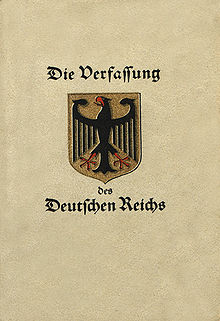- Weimar National Assembly
-
The Weimar National Assembly (German: Weimarer Nationalversammlung) governed Germany from February 6, 1919 to June 6, 1920 and drew up the new constitution which governed Germany from 1919 to 1933, technically remaining in effect even until the end of Nazi rule in 1945. It convened in Weimar, Thuringia and is the reason for this period in German history being known as the Weimar Republic.
With the end of World War I and the start of the November Revolution, Chancellor Max of Baden decided for the abdication of the German Emperor William II on November 9, 1918. The Council of the People's Deputies, a provisional government consisting of three delegates from the Social Democratic Party (SPD) and three from the Independent Social Democratic Party (USPD), took over the executive power on the following day and called for a National Congress of Councils on December 16 to 21 to convene in Berlin. It decided for parliamentary elections to take place on January 19, 1919.[1][2]
The elections yielded a 38% majority for the SPD, with the Center Party getting 20% of the votes, the German Democratic Party (DDP) over 18%, the right-wing German National People's Party (DNVP) just over 10%, and the USPD over 7%. The German People's Party (DVP), Bavarian Peasants' League (BB), German-Hanoverian Party (DHP), Schleswig-Holsteinische Bauern- und Landarbeiterdemokratie (SHBLD), and Brunswick Election-Union (BLWV) each attained less than five percent of the vote. The Communist Party, founded in December 1918, boycotted the elections. The parties were attributed a number of seats proportional to the number of votes they received.[3][4]
The National Assembly met in Weimar for several reasons: the politicians wanted to avoid the ongoing fights in the capital Berlin, and SPD leader Friedrich Ebert wanted to remind the victorious World War I Allies, who were at the time negotiating a peace treaty with a German delegation, of Weimar Classicism, which included the likes of Goethe and Schiller. The assembly convened for the first time on February 6. On February 11, it elected Friedrich Ebert President of Germany. With Philipp Scheidemann (SPD) as Chancellor, the SPD, the DDP and the Center Party formed a coalition government which would go into history under the name Weimar Coalition. On June 23, after long and arduous debates, the government ratified the Treaty of Versailles. On July 31 the Weimar Constitution, which was based on a draft by the DDP member Hugo Preuß, was passed by the assembly, and Ebert signed it into law on August 11.[1][5]
After the first elections based on the new constitution took place on June 6, 1920, the Reichstag took over the role of the National Assembly.[5]
Presidents of the Weimar National Assembly
Name Party Entered Office Left Office Eduard David SPD February 7, 1919 February 13, 1919 Conrad Haussmann (acting) February 13, 1919 February 14, 1919 Konstantin Fehrenbach Centre Party February 14, 1919 June 21, 1920 See also
- Herrenchiemsee convention of 1948
- Parlamentarischer Rat of 1949
References
- ^ a b History of Weimar Republic. germannotes.com. Retrieved December 10, 2007.
- ^ (German)Reichskongreß der Arbeiter- und Soldatenräte in dhm.de/lemo. Retrieved December 10, 2007.
- ^ (German)Election results in dhm.de/lemo. Retrieved December 10, 2007.
- ^ (German)Die Wahlen zur Nationalversammlung in dhm.de/lemo. Retrieved December 10, 2007.
- ^ a b (German)Die Nationalversammlung in dhm.de/lemo. Retrieved December 10, 2007.
Categories:- Weimar Republic
- 1919 establishments in Germany
- 1920 disestablishments
- Defunct unicameral legislatures
- German Revolution of 1918–19
Wikimedia Foundation. 2010.

